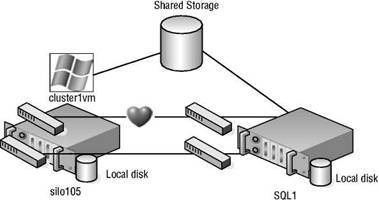Книга: Mastering VMware® Infrastructure3
Physical-to-Virtual Clustering
Physical-to-Virtual Clustering
The last type of clustering scenario to discuss is the physical-to-virtual clustering configuration. As you may have guessed, this involves building a cluster with two nodes where one node is a physical machine and the other node is a virtual machine. Figure 10.24 details the setup of a two-node physical-to-virtual cluster.

Figure 10.24 Clustering physical machines with virtual machine counterparts can be a cost-effective way of providing high availability.
The constraints surrounding the construction of a physical-to-virtual cluster are identical to those noted in the previous configuration. Likewise, the steps to configure the virtual machine acting as a node in the physical-to-virtual cluster are identical to the steps outlined in the previous section. The virtual machine must have access to all the same storage locations as the physical machine. The virtual machine must also have access to the same pair of networks used by the physical machine for production and heartbeat communication, respectively.
The advantage to implementing a physical-to-virtual cluster is the resulting high availability with reduced financial outlay. Physical-to-virtual clustering, due to the two-node limitation of virtual machine clustering, ends up as an N+1 clustered solution, where N is the number of physical servers in the environment plus one additional physical server to host the virtual machines. In each case, each physical-virtual machine cluster creates a failover pair. With the scope of the cluster design limited to a failover pair, the most important design aspect in a physical-to-virtual cluster is the scale of the host running ESX Server. As you may have figured, the more powerful the ESX Server, the more failover incidents it can handle. A more powerful ESX Server will scale better to handle multiple physical host failures, whereas a less powerful ESX Server might only handle a single physical host failure before performance levels experience a noticeable decline.
- Clustering Virtual Machines
- Virtual Machine Clustering Scenarios
- Chapter 5 Installing and Configuring VirtualCenter 2.0
- Глава 2 Виртуальные машины Virtual PC 2004
- Why Virtualization Is a Smart Idea
- Virtualization Versus Paravirtualization
- Configuring Virtual Host Properties
- Virtual Hosting
- Address-Based Virtual Hosts
- Name-Based Virtual Hosts
- Passwords and Physical Security
- Physical Structure of the File System on the Disk




